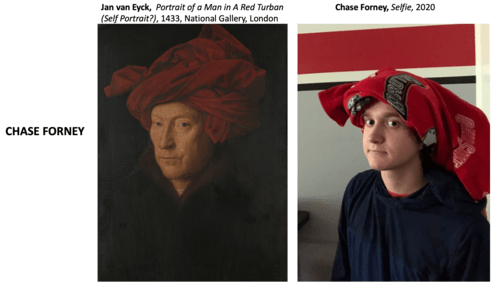BGSU art history students reimagine artists’ iconography in modern-day selfies

From Renaissance self-portraits to contemporary selfies
By Julie Carle
An assignment in Dr. Allie Terry-Fritsch’s art history class at Bowling Green State University provided a lesson in iconography and resourcefulness.
Students in the Northern European Renaissance Art History course studied self-portraits of that region’s Renaissance artists and used that knowledge and items they found at home while sheltering in place to create modern-day selfies.
The project, one that Terry-Fritsch, associate professor in the School of Art, has assigned during that class for many years, had new challenges this year, the year of COVID-19. About half-way through the semester, the class switched from in-person to online and for this project students were expected to only use things found at home during the coronavirus shelter-in-place restrictions, she said.
The students carefully researched the artistic and social context of self-portraits of artists such as Bartholomeus van der Heldt, Simon Bening, Catharina van Hemessen, Albrecht Durer, Jan van Eyck, Hans Baldung, Lorenzo Lotto and Anthony van Dyck. They were asked to “consider self-fashioning in artists’ portraits of themselves and then to consider their own strategies to fashion their identities in 2020,” Terry-Fritsch said.
Students were asked to consider “the composition, iconography and expressive content of their selfie and describe how their portraits relate to the originals. It is a creative way to explore many art-historical concepts while at the same time referencing the key artistic strategies of the period,” she said.
Kit Frye, a student in the class, chose artist Lucas Cranach the Elder, in part because he was fascinated with the red head piece from Cranach’s self-portrait.
“I found out the portrait was part of a larger portrait he completed for his own marriage,” Frye said.
Cranach portrays himself as “a family man whose art is close to God,” Frye said. “Because I am neither of those things,” her selfie reflects those differences.
“I stripped the original intention of the portrait as a marriage commemoration and now it serves as a display of my ability to transform an Anastasia Beverly Hills contour palette into a scruffy beard,” she said.
Frye fashioned her version of the red headpiece, and completed the with a yoga mat and a coffee cup in the background, showing her devotion to caffeine and exercise.
Elizabeth Morrell studied a somewhat unknown portrait of Hans Holbein the Younger for her project. She was intrigued by “the expression Holbein wears in his portrait, because it struck me how different he looked compared to early self-portraits he had done.
“He traveled and was very active in his lifetime and it showed in his features. He looked a bit withered and surly and I loved that, so I decided to focus on that for my selfie.”
Sporting a brown beret, a turned up collar and an expression like Holbein’s, Morrell’s selfie captures a moment of 2020 for her.
“I learned that there is never simply one answer for why an artist paints or draws their own likeness. I think he did the self-portrait to commemorate his life, one last time without all of the pomp he used in his previous portraits,” she said.
After the fun virtual presentation of everyone’s selfies, Terry-Fritsch shared many of the selfies to the Museum Art Challenge, an international museum initiative which asked people who were sheltering at home to recreate a work of art in a museum’s collection. Additionally, she and her husband, Dr. Stefan Fritsch, a political science professor, recreated artist Marc Chagall’s “Over the Town“ and shared it in the coronavirus art challenge.
Updated: 07/01/2020 01:41PM












